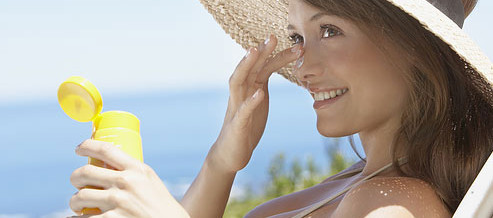
Summer is in high-gear, and as we all hit the pool now is the time to be prepared for the hot sun on our back. While the best “sunscreen” is to avoid the sun altogether, that sure can put a damper on your pool party. So it’s off to the market to grab your lotion of choice; but which one is the best?
First, there’s no such thing as “sunblock” as no lotion, spray or powder can completely “block” the sun. Something is going to get through. Furthermore, the SPF, or “Sun Protection Factor”, can sometimes lead us into a false sense of security causing us to not apply as often or as much of our sunscreen. Here are a few basic tips when choosing the right sunscreen:
- Avoid sprays, powders and any SPF above 50+
- Sprays and powders can be breathed in and may cause lung damage. While the jury is still out on this, investigations are still underway. Why take the risk when you can use something potentially safer? Any SPF above 50 can be misleading as it may only refer to UVB radiation and not UVA radiation. Ultraviolet-B (UVB) causes sunburns, while ultraviolet-A (UVA) doesn’t cause sunburn but can increase the rate of melanoma and photodermatitis.
- Look for water resistant (beach, pool and exercise) creams or lotions that have broad spectrum protection. Use SPF 30+ for beach and pool.
- Sunscreens are made of either chemical compounds or particulates. The latter can be either organic or inorganic. All categories either reflect, deflect or absorb UV radiation. Some compounds can cause disruptions in hormone pathways and other physiological processes, or even contribute to cancer. On another note, “sun lotion” is designed to amplify the sun’s radiation, not reduce it.
Compounds in suncreens to avoid are oxybenzone, retinyl palmitate (vitamin A), or any added insect repellent. Instead, look for safer ingredients in sunscreens like zinc, titanium dioxide, avobenzone or Mexoryl SX.
Lastly, be mindful of your Vitamin D level. The more we cover up, the less Vitamin D our bodies can make. Check with your healthcare practitioner about Vitamin D testing or supplementation. Ironically, Arizona has one of the highest levels of Vitamin D deficiency in the country!
Here are some sunscreen tips:
- Cover up with protective clothing and a sunhat.
- Make shade with a canopy or an umbrella.
- Avoid midday sun – take walks in early morning or late afternoon.
- Test your sunscreen on your child’s wrist the day before applying to see if they have a reaction.
- Reapply often!
- Make using sunscreen a habit and start when your kids are young.
These are few suggestions for some quality sunscreens:
- Adorable Baby Sunscreen Stick – Good UVB/UVA Balance, excellent stability and low health concern.
- TerraSport Face Stick – Good UVB/UVA Balance, excellent stability and low health concern.
- Aubrey Organics Natural Sun Green Tea Sunscreen – Good UVB/UVA Balance, excellent stability and low health concern.
- Badger Baby Sunscreen, Chamomile & Calendula – Good UVB protection, excellent UVA protection and overall stability and a low health concern.
For more sunscreens, visit the EWG Best Sunscreen List.
ShareJUN

About the Author: